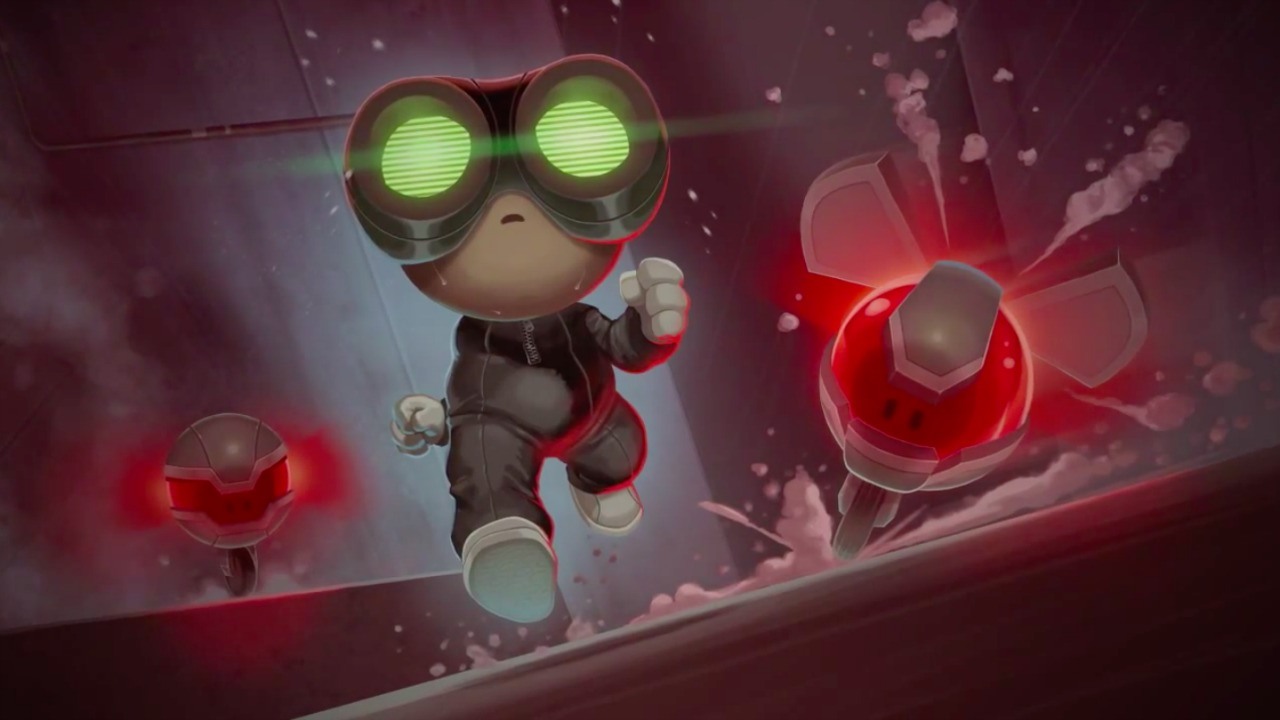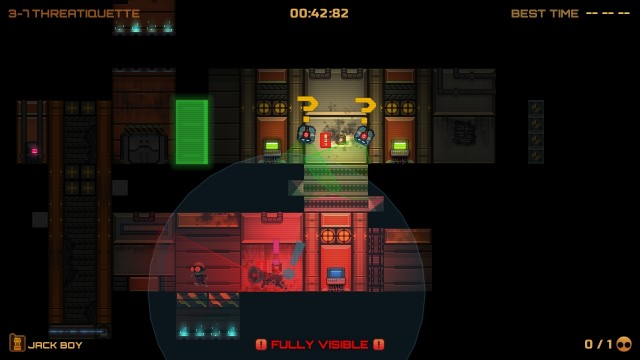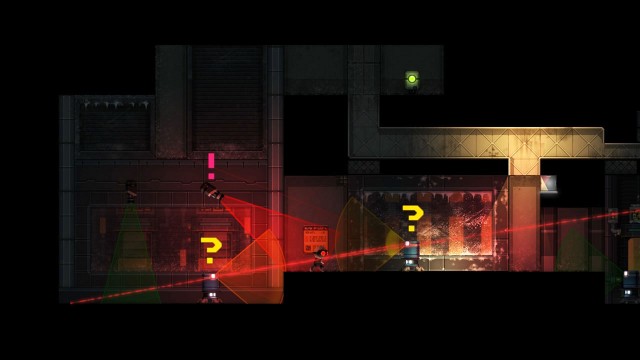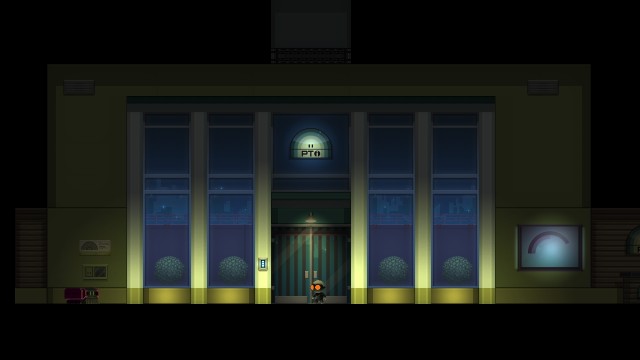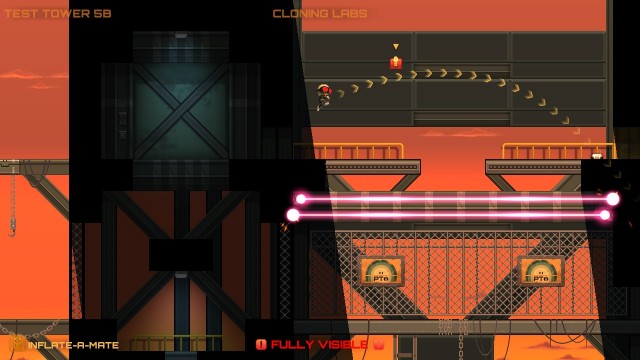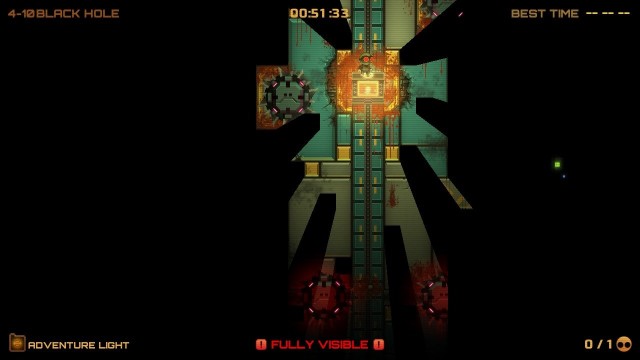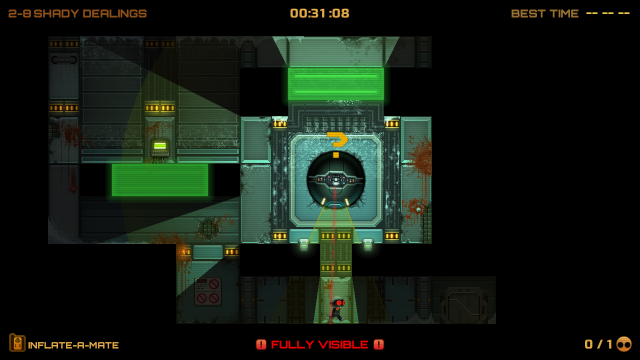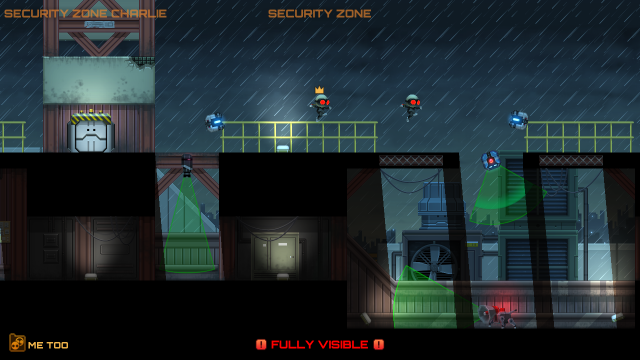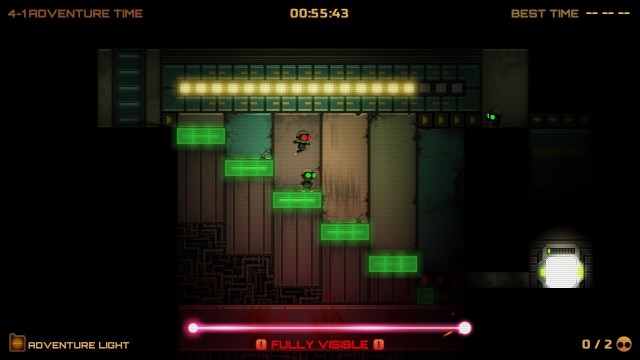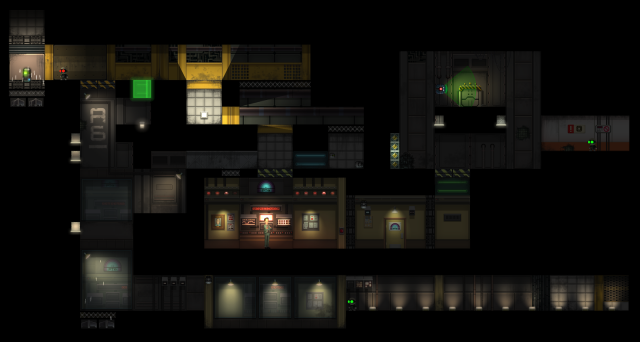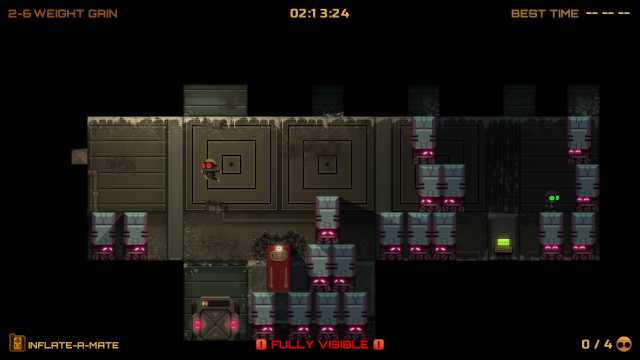UPDATE: While our review primarily focuses on the initial Wii U release of Stealth Inc 2: A Game of Clones, we have added additional sections to address the belated ports for PC, PS4, PS3, PS Vita, and Xbox One.
Stealth Inc.: A Clone in the Dark is a masterpiece of masochism, one that you would know by the moniker of Stealth Bastard Deluxe if you played its original PC build. It was a brilliant and well-designed game on all of the platforms that hosted it, even if it was also an often crushingly difficult and brutally harsh one at the same time.
While the game ultimately ended up being exclusive to PlayStation in the dedicated gaming space, excluding its PC and mobile versions, there were plans made between developer, Curve Studios and Nintendo to port Stealth Inc.: A Clone in the Dark to Wii U. following Curve’s work on Nintendo’s well-received Fluidity games. These plans unfortunately fell through, but considering that Curve got their start with Nintendo’s help thanks to Fluidity, the well-regarded indie developer wished to make amends somehow.
Thus, a sequel, Stealth Inc. 2: A Game of Clones was born! Despite the original not appearing at all on Nintendo platforms, Stealth Inc. 2: A Game of Clones is completely exclusive to Wii U, not even seeing PC or mobile releases for its launch. This may seem odd, but it’s a big boon for Nintendo gamers, as Stealth Inc. 2: A Game of Clones is even more brilliant and refined than its predecessor! The game feels very effectively tailored for Wii U specifically, surprisingly so, yet still manages to deliver a challenging and wholly satisfying adventure, cutting down on some of the frustration as well.
If you’re a serious gamer that owns a Wii U, regardless of whether or not you’ve played the original game, Stealth Inc. 2: A Game of Clones presents one of the best core gamer offerings currently available on the Wii U eShop, and one that is well worth its $14.99 asking price. You’ll get even more out of the experience if you’ve played through and enjoyed the original game, and happen to own a Wii U for the sequel as well, which makes the murderous playground of PTI Industries noticeably more fun than it was before!
Stealth Inc. 2: A Game of Clones is a game of many strengths. The only place where it tends to falter is in the visuals, which feel a bit bland and uninteresting. The game adds some improved detail in the character models and hazards, taking advantage of some of the Wii U’s added power over the PS3 and similarly-powered platforms that hosted the original Stealth Inc.: A Clone in the Dark, but considering that you spend much of the game in the shadows, that doesn’t amount to much.
In fact, it’s the same old constant shadows that often drag down Stealth Inc. 2: A Game of Clones in the graphics department. Too much of the game is just drab to look at, with the same shadowy corridors quickly all blending into each other. The splashes of light and colour, and the brisk character animation are all satisfactory for Wii U standards, but certainly nothing special. A few sections of the game’s open-world area outside of the main stages do take you to a few more noteworthy locations, such as a scrapyard, a stormy outdoor exterior, and a rather tongue-in-cheek lounge area, which helps give PTI Industries far more character than it had in the first game, but the actual Test Chambers that serve as the main stages all have the same bland visual assets for the most part.
On the bright side, performance in the game is perfectly consistent and smooth, and the fact that it’s an independent Wii U eShop game running at a full 60fps is very impressive! The 60fps demand can be a little taxing during co-op sessions though, with two-player gameplay resulting in noticeably fuzzier, choppier animation, particularly in the more visually busy Test Chambers. It’s certainly manageable, but it does give the impression that the asymmetric co-operative gameplay is straining the hardware.
Stealth Inc. 2: A Game of Clones also supports off-TV play for those playing solo, as with most other Wii U games, with those in single-player gameplay able to freely switch between the television and the Wii U Gamepad Screen with a tap of the -/Select Button. The game performs just as well when played on the Wii U Gamepad Screen, though those with less-than-great eyesight will likely prefer to play on the television, since the compressed resolution of playing on the Wii U Gamepad makes vents, dark passages and other such small details in the environment noticeably harder to spot.
The original Stealth Inc.: A Clone in the Dark wasn’t all that visually ambitious, and Stealth Inc. 2: A Game of Clones is pretty visually modest itself at the best of times. At least it touches up the visuals where it counts though, and at least the gameplay is still as smooth and engaging as ever on Wii U.
The original Stealth Inc.: A Clone in the Dark already had a pretty solid musical score, but the sequel’s soundtrack is better and catchier than ever! Stealth Inc. 2: A Game of Clones is packed with intense synth tunes that are very easy to bop and hum along with as you play, and all of them help to create an atmosphere that is as cool as it is crushing.
Every time you restart a stage, or poke around different parts of the main open-ended corridors of the PTI building, you’ll get treated to a handful of different tracks prepared for that Stage Sector or PTI Area. This may help to cushion the blow of having to restart an especially tough Test Chamber more than once, since the music will change every time you restart, often to another equally rad sci-fi beat. There isn’t one piece of music in Stealth Inc. 2: A Game of Clones that doesn’t feel awesome to listen to, and if you play on the Wii U Gamepad Screen, plugging in a pair of headphones may allow you to get even more out of the fantastic music!
Sound effects feel pretty well unchanged from the original Stealth Inc.: A Clone in the Dark, but that’s fine, since they didn’t need any improvements anyway. The ominous sighs and shifts of open gates and doors, along with the telltale ‘boop’ noise that plays when you’re spotted by a sentry, sound as foreboding as ever, and constantly keep players on their toes. Likewise, the stomach-turning squish that sounds whenever your clone is obliterated by a laser or a saw blade or anything else, continues to make each painful death sting all the more. There’s no way to die well in Stealth Inc. 2: A Game of Clones, and that will encourage players to be extra careful!
Stealth Inc. 2: A Game of Clones continues to be devoid of voice acting, just like its predecessor, but that’s alright, since it helps to create a sense of nihilism for the game world, where even your little clone hero is oh-so-disposable. Still, as heartless as it can often be, the audio is very well-produced all-around, and makes the entire game feel very cool and easy to enjoy for hardcore gamers, even if it’s constantly humiliating them with its often ruthless stage design.
Stealth Inc. 2: A Game of Clones, while still fundamentally a stealth-themed puzzle-platformer that aggressively punishes even slight mis-steps with death, has undergone some significant design changes in contrast to the original Stealth Inc.: A Clone in the Dark. The core objective of each stage, or Test Chamber, is still simply to hack each Terminal by holding the Y Button for a short time when standing in front of one, and then reaching the exit door when every Terminal is hacked, though that’s practically where the progression similarities to the first game end.
Chief among the changes in the sequel is the fact that the game is no longer broken up into just a selection of stages that players choose from a menu as they progress. Instead, Stealth Inc. 2: A Game of Clones now unfolds in an open-ended environment, akin to Metroid or Shantae, with the player’s clone character having gotten loose from the main testing process at PTI Industries, and exploring the corridors and offices of the building. As with other Metroid-style games, a certain amount of the environment will be open to players as they progress, with new areas opening up as they acquire new capabilities that allow them to open new paths.
This design tweak is much more than a gimmick though. The change to an open-ended PTI environment allows players to feel better rewarded for making use of Gadgets, which are another huge new design tweak in the second game. As players enter new sections of the PTI building, where they must find and enter the eight Test Chambers in each, calling back to the eight-stage Sector structure of the original game, each new section will feature a different Gadget. Each Gadget creates an awesome new way to spice up gameplay with each of the six main Sectors of the PTI Building, which are conveniently colour-coded when viewed on the dynamic map that can be freely accessed on your Wii U Gamepad Screen while playing on the television.
Not only is each Gadget fun and well-designed, easily dropped and retrieved with the ZR Trigger and toggled with the ZL Trigger, but they also present a much smoother and more refined difficulty curve in contrast to the first game’s sometimes-awkward difficulty spikes. The joy of discovering a new Gadget is great fun in the early Test Chambers of a new Sector, and by the time you reach the eighth Test Chamber in a Sector, where you once again try to elude the all-seeing and highly-dangerous Sentinel foes from the first game (who can now move in the sequel!), you’ll feel like you know the Gadget intimately. Something as simple as an inflatable platform for example can also be used for a boost jump, a laser blocker, or even a way to flatten foes! There’s even a very cool cloning gadget that feels undeniably inspired by Curve Studios’ work porting award-winning indie puzzler, The Swapper to PlayStation and Wii U.
After you clear a Sector, you’ll soon after gain the ability to use a Gadget at your leisure in the main PTI building environment, which opens up new paths, and can allow you to find hidden goodies if you backtrack to earlier areas. Unlike the Test Chambers, you’re not limited to one Gadget in the open PTI building environment, and can switch between any Gadget you’ve earned outside of the Test Chambers by holding the X Button and simply cycling through them with the Control Pad. By that time, you’ll have gotten so good with the Gadgets, that you can track down all sorts of cool extras with them pretty easily, namely hidden hats and costumes that you can freely toggle on your clone using the Wii U Gamepad Screen.
Should you get stumped with the level design, or how to use your Gadgets to proceed ahead in the main PTI corridors, Stealth Inc. 2: A Game of Clones also makes excellent use of Miiverse. If you opt to activate Miiverse in your game (and you should!), you can tap Y whenever you pass by a Miiverse icon to read messages left by other players from that location in the game. These are sometimes nonsense or pure frustration, but more often than not, Miiverse messages also contain helpful hints that will keep players motivated, and help them get a tip as to how to proceed if they feel like they’re getting frustrated themselves. They also tend to show up right when you need them to, and give players incentive to leave their own hints and tips to help others, or just leave something entertaining that will make another player chuckle, making Stealth Inc. 2: A Game of Clones a more enjoyable experience than it would have been with no Miiverse functionality.
Another potential way to help players gain an edge is to play in local co-op (sadly, online co-op is not supported), even if this does task the framerate a tad. Curve Studios could have simply designed a half-baked co-op mode that simply had two players running around the PTI building and Test Chambers together, but they took it one step further, to great effect!
When playing in co-op, one player uses the Wii U Gamepad, while another uses a Wii U Pro Controller or Wii Remote/Nunchuk configuration. The Wii U Gamepad user takes a passive role, while the other player controls the clone, and can move about the entire game as they could when playing solo. In co-op however, the person using the Wii U Gamepad can use a limited amount of perks with the stylus, such as shielding the clone from sight, or distracting enemies with a fake clone, and can also draw on the television using the Gamepad’s stylus, allowing them to literally point out tips for helping the other player figure out how to progress.
To compensate for the advantages of playing in co-op, certain enemies will become invisible on the television when a second player joins in. This requires the person on the Gamepad to pay attention to both the Gamepad Screen and the television, and hold the stylus on invisible enemies to make them visible to the other player playing on the television. Likewise, when the clone hacks a Terminal, the clone’s player must call out three numbers when they press Y, rather than just holding the button, which the Gamepad user must then quickly type in on a keypad, using the stylus, especially if the clone must work quickly to avoid being killed while hacking.
This creative use of the Wii U hardware is outstanding, and it really makes Stealth Inc. 2: A Game of Clones feel like a true Wii U passion project. You’d never know that the previous game wasn’t even made available on Nintendo platforms, because the sequel makes the Stealth Inc. brand feel like it was most at home on Wii U to begin with. This also proves in one of the best ways yet that hardcore gamers can really benefit from the unique Wii U hardware in a way that isn’t possible on the competing PS4 or Xbox One, nor the PC, and it provides an imaginative precedent for more Wii U-dedicated indie games to make more novel use of the hardware.
Strangely though, the game seems to ‘lock’ players into playing with the Wii U Gamepad when playing solo, despite the most ambitious Gamepad uses being in co-op. It’s not so bad, since the Wii U Gamepad controls are plenty comfortable and intuitive, but it begs the question of why solo players can’t use a Wii U Pro Controller at the very least, which feels like the ideal way to control the clone. The Wii Remote/Nunchuk configuration is decent too, if you want to play co-op and don’t own a Wii U Pro Controller, but the fact that you’re forced to use the Wii U Gamepad when playing solo feels needlessly limiting, especially when the rest of the game feels so polished and ambitious for an indie game on the Wii U.
The main game will last anywhere from 6-12 hours or so during the first playthrough, depending on how patient players are, and how good they are at puzzle-solving. Hidden costumes, secret stages and online leaderboards beg for replayability and mastery of the game though, especially since you can freely access any completed Test Chambers from the game’s main menu.
As with the original Stealth Inc.: A Clone in the Dark, Stealth Inc. 2: A Game of Clones also sports a level editor, and mercifully, this one actually allows you to share your custom stage designs online with other players, which the first game maddeningly didn’t allow. The highest-rated custom stage designs still don’t compare to Curve Studios’ actual Test Chamber designs for the sequel, which are universally outstanding, but at least they will help fans keep finding new challenges to enjoy. It is a shame that the level editor is missing some of the assets and hazards from the official developer-made Test Chambers in the main game though, and while the quick, simple drag-and-drop design is pretty intuitive and easy to work with on the Wii U Gamepad Screen, the editor is still a bit middling overall, and more of a cool extra than an essential feature.
Stealth Inc. 2: A Game of Clones still represents some of the most inspired and just plain cool design in a Wii U indie game though, particularly for hardcore gamers. It’s all-around a smoother and more refined sequel, as well as one of the best investments that one could make on the Wii U eShop, if they’re up to the challenge.
Stealth Inc. 2: A Game of Clones is a pretty simple proposition on PC, having bare-bones system requirements that even allow it to run pretty easily on a dated computer running Windows XP, with barely any hard drive space. This is also noticeable in the technical elements of the game, which aren’t too impressive, even for an indie game built on relatively simple assets.
Still, the game is as enjoyable as it ever was on PC, giving PC gamers a chance to finally enjoy the sequel if they’ve already played through the original Stealth Bastard Deluxe, and don’t own a Wii U. The PC version of Stealth Inc. 2: A Game of Clones does come with gamepad support as well, which is essential, as trying to play with a keyboard results in very loose, unreliable controls that will just repeatedly get you killed.
Seeing as the PC version is entirely missing the Wii U-specific bonuses, such as co-op, Miiverse and the like, and the Steam Achievements are paltry and unsatisfying, the PC version comes off as feeling like a lesser port of the Wii U original. Avid PC gamers who enjoyed Stealth Bastard Deluxe a lot may find it worth the download, but beyond that, it’s a bit of a disappointment.
As for PlayStation gamers, they’re also getting a downgraded port of the Wii U original, which is a shame. Despite the fact that the PS4 is noticeably more powerful than the Wii U, even the PS4 version of the game suffers from jagged, ill-defined textures, which is no doubt a side effect of the secondary ports of Stealth Inc. 2: A Game of Clones being outsourced to Carbon, not done in-house at Curve Studios. The PS4, PS3 and PS Vita versions all fail to live up to the technical prowess of the Wii U version, though fortunately, they all still run at 60fps at least, even though the PS Vita version takes a bit longer to load up, naturally.
The PS4 and PS3 versions are more or less identical, both missing co-op and other bonuses from the optimal Wii U version, which is even more of an expected omission on the portable PS Vita. The PS3 version caps at 720p resolution, whereas the PS4 version makes it to native 1080p, but it’s not too noticeable, given the game’s modest technical design. The problem with many darkened areas being harder to spot on a smaller screen is also a pretty big issue on PS Vita, especially if you’re playing on a PS Vita Slim, which has a less sharply-lit screen. The PS Vita port does at least offer portability, something that none of the other versions do, but it comes at the cost of having to squint at everything in most cases, since this is a game clearly built to be played on a larger television display.
Stealth Inc. 2: A Game of Clones is cross-buy on PlayStation, so you’ll net the PS4, PS3 and PS Vita versions together with a single purchase of any of them, and that’s a plus, as is the shared trophy roster. Disappointingly however, the cross-buy element is somewhat for naught, as there’s no cross-save function (which is bizarre, as the original Stealth Inc.: A Clone in the Dark can easily share save files between PS3 and PS Vita), which means that your progress will be confined to whichever platform you play on. The trophy list is also very small, and predictably lacks a Platinum Trophy.
Again, if you played the original Stealth Inc.: A Clone in the Dark on PlayStation, and simply want access to the sequel on PlayStation platforms, here it is. It’s a rudimentary port with several features missing from the Wii U original however, and a complete lack of cross-save capability. As far as PlayStation ports go, the PlayStation versions of Stealth Inc. 2: A Game of Clones are functional, but feel half-baked and disappointing.
Stealth Inc. 2: A Game of Clones coming to Xbox One will finally give Xbox gamers a chance to put their skills to the test in Curve’s highly challenging indie stealth-platformer series. Unfortunately though, as with the PC and PlayStation versions, the Xbox One version of the game is a lesser port of the Wii U original, yet again forced to make-do with less-defined and sloppy textures and shading in contrast to the original Wii U release.
Yet again, co-op and other Wii U-specific bonus features like Miiverse, along with anything that utilized the Wii U Gamepad, are entirely missing in the Xbox One version of Stealth Inc. 2: A Game of Clones. The missing features are at least balanced out by a small handful of achievements, all of which are very valuable, ranging from 50-200 Gamerpoints, and might be a draw for avid achievement hunters who don’t mind the high degree of challenge.
That said though, unless you’re an avid Xbox gamer that’s dying to give this series a try, there’s little standout appeal in the Xbox One port of Stealth Inc. 2: A Game of Clones, beyond its highly valuable achievements. If you don’t care about those draws, there’s nothing here that elevates itself above other, better games on the Xbox One Games Store.
Stealth Inc. 2: A Game of Clones even outshines a good chunk of full retail games available on Wii U, thanks to its very exceptional use of the unique hardware, and its absolutely brilliant challenge and stage design. The ambitious design tweaks make for an overall improved and more enjoyable experience in the sequel, and while the game is still more challenging than most modern games, indie or otherwise, it’s not quite as crushingly infuriating as its predecessor could often be.
Even if you crave the die-hard masochism of the original Stealth Inc.: A Clone in the Dark though, Stealth Inc. 2: A Game of Clones will still satisfy you, since it’s still packed with smart challenge, and plenty of incentive to master the game. As with the first game, attaining the ultimate S-Rank in each Test Chamber, and mastering every challenge that the game throws at you, is a task fit only for the most devout, patient and fearless of gamers! Even if you’re more in it for the entertainment value though, Stealth Inc. 2: A Game of Clones still effortlessly manages to be significantly more fun than its predecessor, and the combination of infinite lives and retries, and a slew of Miiverse comments littered throughout the game that range from helpful to highly amusing, will keep players pressing on, even when the going gets tough. The same is true of the same dark, twisted sense of humour throughout the experience as well, which is alive and well from the first game.
If you fancy yourself a serious gamer, and you own a Wii U, Stealth Inc. 2: A Game of Clones simply must be played! It represents a higher standard of Wii U game development, especially for indie games, and it succeeds both as an excellent use of the hardware, and a highly enjoyable experience on its own merits. It may be a rather unlikely sequel, particularly given how proudly it shuns its original platforms for full Wii U exclusivity, but it’s still one of the best sequels that independent game development has ever produced!

